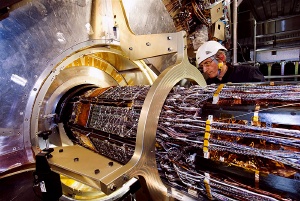Jun 8 2009
Two Iowa State physicists say there's some science fiction in "Angels + Demons." But they're not quibbling because the movie is introducing millions to particle physics. Soeren Prell admits to being amused by some of the high energy physics portrayed in "Angels + Demons," the summer thriller starring science, religion and Tom Hanks.
 A technician helps install the pixel detector within the ATLAS detector at the Large Hadron Collider near Geneva, Switzerland. A team of Iowa State physicists is contributing to work on the pixel detector, the innermost part of the ATLAS experiment. Photo by Claudia Marcelloni, the European Organization for Nuclear Research.
A technician helps install the pixel detector within the ATLAS detector at the Large Hadron Collider near Geneva, Switzerland. A team of Iowa State physicists is contributing to work on the pixel detector, the innermost part of the ATLAS experiment. Photo by Claudia Marcelloni, the European Organization for Nuclear Research.
Take, for example, scenes depicting CERN, the European Organization for Nuclear Research near Geneva, Switzerland, and its Large Hadron Collider, the $8 billion, 17-miles-around particle accelerator.
The collider is the world’s biggest science experiment. It will accelerate beams of protons or lead ions to nearly the speed of light and crash them together so physicists can study the subatomic particles that fly off. Physicists are hoping the experiment will find the Higgs boson, a subatomic particle that could be a key to explaining how particles acquire their masses.
Prell, an Iowa State University associate professor of physics and astronomy, has visited CERN many times. And he says the scenes showing windowed corridors full of physicists walking past the collider tunnel are “completely unrealistic.”
There’s radiation in the tunnel, which is buried 100 meters below ground. When the experiment is running, Prell said the collider is not a place for people. Even the equipment has to be specially built to work properly in the collider’s radiation.
Jim Cochran, an Iowa State associate professor of physics and astronomy who is traveling to CERN this week for physics meetings, agreed the movie takes poetic license with the science of particle physics.
But, he said he enjoyed seeing shots of CERN up on the big screen. The movie’s opening sequence features shots from inside the service building for the collider’s ATLAS experiment. The building is just a five-minute walk from the offices used by Iowa State physicists at CERN.
Prell and Cochran are part of an Iowa State team contributing to ATLAS, one of the collider’s two general-purpose particle detectors. It’s a huge instrument – 46 meters long and 25 meters high – designed to track the paths, energies and identities of everything that flies from particle collisions.
The two Iowa State physicists said the film’s treatment of antimatter as the active ingredient in a powerful bomb is another case of moviemakers dramatically stretching scientific facts.
Prell said antimatter has been known to science for about 80 years. It’s something produced by cosmic radiation, radioactive decay (Iowa State students use this type of decay to briefly create electrons and anti-electrons in a physics lab) and the collisions inside particle accelerators.
In Dan Brown’s best-selling novel and Ron Howard’s movie depiction, a quarter gram of antimatter (a dollar bill weighs about a gram) is trapped in a small container that could be used to produce a bomb powerful enough to destroy Vatican City.
It’s true that any contact between matter and antimatter results in annihilation. In the Large Hadron Collider, the antimatter that’s created annihilates within fractions of a second. (The energy of those annihilations is measured by Einstein’s famous equation E=mc², energy equals mass times the speed of light squared. The speed of light squared is a very big number so the equation means very small amounts of mass can, indeed, release enormous amounts of energy.)
Prell said it takes a very good vacuum to store antimatter. It also takes powerful magnetic and electrical fields to keep the antimatter suspended within the container and away from its walls.
That’s not easy to do. CERN says the world record for trapping and storing a single antiproton is 57 days.
Besides, if you really want antimatter, Cochran said the Midwest is the place to go. Fermilab, a U.S. Department of Energy national laboratory in Batavia, Ill., produces antiprotons to collide with protons in the four-miles-around Tevatron accelerator. But Fermilab scientists say it would take them 70 million years to create a quarter gram of antimatter.
Cochran and Prell can tell you about other science fiction in the movie. But they don’t want to quibble because the movie is introducing high energy physics to millions of people.
“I think it’s good to comment on the science of the movie so we can reduce misconceptions about what our research is capable of doing before the wrong pictures settle in people’s minds,” Prell said.
Cochran agreed, saying, “A good thing is that people might see this movie and think about the physics. And maybe it will inspire some people to go to Wikipedia and look up the Higgs boson.”